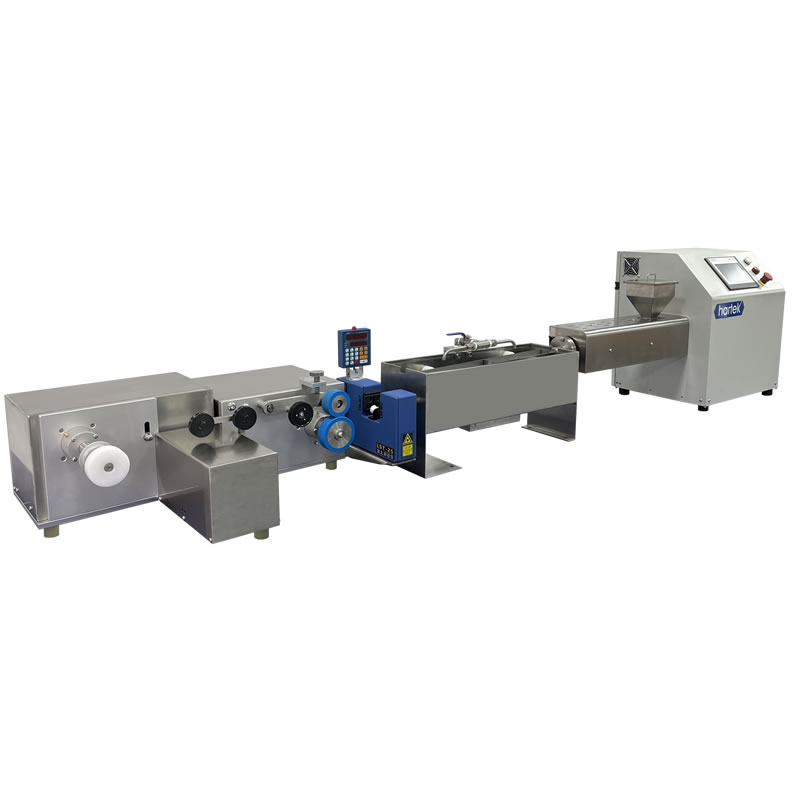Setting up a pipe production line efficiently requires meticulous planning across several key areas: understanding your product, selecting the right technology, designing the workflow, and implementing robust operational practices.
Here is a comprehensive, step-by-step guide to efficiently set up a pipe production line, covering everything from initial planning to full-scale production.
Phase 1: Strategic Planning & Feasibility (The Foundation)
Efficiency starts long before you buy any equipment.
1. Define Your Product Portfolio:
- Type of Pipes: Will you produce PVC, HDPE, PP, CPVC, ABS, or composite pipes?
- Applications: Pressure pipes, sewer/drainage, conduit for electrical, gas distribution, etc.
- Sizes & Standards: Determine the diameter range (e.g., 16mm - 630mm) and pressure ratings (e.g., PN6, PN10, PN16). Your products must comply with international (ISO, ASTM) or local national standards.
- Output Goals: Define your target production capacity in kilograms or meters per shift (e.g., 1,000 kg/hr or 500 m/hr).
2. Market & Raw Material Analysis:
- Supplier Reliability: Identify reliable suppliers for your primary polymer (compound) and additives (color masterbatch, stabilizers). Consistent raw material quality is non-negotiable for efficient production.
- Location: Choose a facility with easy access to both your raw material suppliers and your target customer base to minimize logistics costs.
3. Factory Layout Planning:
- Flow is Key: Design the layout for a logical, linear material flow:Raw Material Storage -> Drying/Pre-heating -> Extrusion -> Cooling -> Haul-Off -> Printing -> Cutting -> Stacking/Packaging -> Finished Goods Storage.
- Space Allocation: Ensure ample space for:
- Raw material silos or storage.
- The main extrusion line (length is critical for cooling tanks).
- Post-processing (e.g., socketing, belling).
- Quality control lab.
- Finished product storage and loading bays.
Phase 2: Technology & Equipment Selection (The Hardware)
Invest in the right technology for your specific needs. Don't just buy the cheapest option.
1. The Extruder: The heart of the line.
- Type: Single-screw extruders are common for most standard pipes. Twin-screw extruders are better for powder-based PVC formulations and offer superior mixing.
- Size: Sized by screw diameter (e.g., 45mm, 65mm, 90mm) and L/D ratio (Length/Diameter). A higher L/D ratio (e.g., 30:1 to 33:1) provides better melting, mixing, and stability.
- Output: Match the extruder size to your target output goals.
2. The Die Head (Tooling):
- This forms the pipe's cross-section. It consists of a mandrel (forms the inner diameter) and a die (forms the outer diameter).
- Ensure quick-change capabilities for different sizes to minimize downtime during product changeovers.
3. Cooling System:
- Vacuum Calibration Tank: The most critical element for dimensional accuracy. A vacuum tank with precisely sized calibration sleeves sets the outer diameter and cools the pipe's outer surface.
- Spray or Immersion Cooling Tanks: Further cool the pipe to its core. Longer cooling tanks allow for higher line speeds.
4. Ancillary Equipment:
- Haul-Off (Puller): A caterpillar-type puller that provides constant, steady traction. It must be synchronized perfectly with the extruder's output speed.
- Cutter: An automatic traveling cutter (saw or router) that cuts the pipe to length without stopping the line.
- Printer: An inline ink-jet or hot-embossing printer to mark the pipe with brand, size, standard, and production date.
- Stacking/Packaging: Automated stackers, bundlers, or coiling equipment to handle the finished product, reducing manual labor.
Phase 3: Installation & Commissioning (The Setup)
1. Professional Installation:
- Work with the equipment supplier's engineers to ensure the line is installed on a level, stable foundation and all utilities (high-power electricity, compressed air, water cooling circuits) are correctly connected.
2. Thorough Commissioning:
- This is a hands-on training period. The supplier's technician should:
- Check all mechanical and electrical systems.
- Run the line and fine-tune the process parameters (temperatures, screw speed, haul-off speed, vacuum levels).
- Train your key operators and maintenance staff on operation, troubleshooting, and basic maintenance.
Phase 4: Operational Excellence (The Software & Processes)
This is where true efficiency is achieved daily.
1. Process Optimization (The "Recipe"):
- Document the optimal settings for each product (extruder temperatures, screw speed, haul-off speed, vacuum pressure). This is your "Golden Recipe."
- Use Statistical Process Control (SPC) to monitor key variables and make data-driven adjustments.
2. Raw Material Handling:
- Use centralized silos with pneumatic conveying systems to feed the extruder hoppers. This reduces manual handling, contamination, and moisture uptake.
- Implement First-In-First-Out (FIFO) inventory management for raw materials.
3. Changeover Reduction (SMED):
- Single-Minute Exchange of Dies: Standardize and streamline the process of changing from one pipe size to another.
- Internal Tasks: Do as much prep as possible while the line is still running (e.g., pre-heating the new die, preparing tools).
- External Tasks: Perform tasks after the line is stopped (e.g., physically swapping the die).
- The goal is to minimize downtime during product changes.
4. Predictive & Preventive Maintenance:
- Preventive: Create a strict schedule for cleaning filters, checking calibrators, greasing bearings, inspecting screws and barrels.
- Predictive: Use vibration analysis, thermal imaging, and motor current monitoring to predict failures before they cause unplanned downtime.
5. Quality Control Integrated into the Line:
- In-line: Use laser gauges or ultrasonic sensors to continuously monitor the pipe's outer diameter and wall thickness, providing instant feedback to the operator.
- At-line: Have a QC lab at the production floor to frequently test samples for dimensions (diameter, ovality), impact strength, and melt index.
- Catch defects immediately to avoid producing large amounts of scrap.
6. Skilled Workforce:
- Invest in continuous training for operators, mechanics, and electricians. They should understand not just how to run the line, but why the process works the way it does.
By following this structured approach, you can set up a pipe production line that is not only efficient from day one but is also designed for continuous improvement, high quality, and long-term profitability.
Contact Us:-
Business Name: Hartek Technologies Co.,Ltd
Email Address: [email protected]
Website:- https://www.labextrusion.com/
Full name : Lab Extrusion





Comments